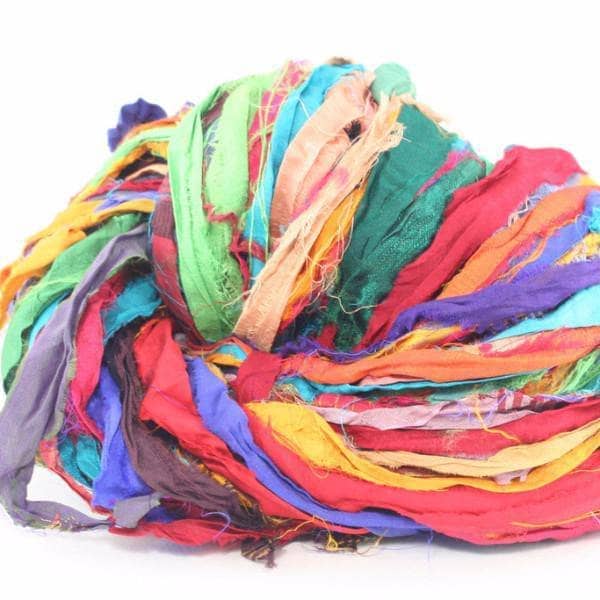Written by Kate Curry
What Is Recycled Silk Yarn?
Silk is a natural fiber that is created by insects! Caterpillars, worms, and even some crickets make the cocoons from which silk proteins can be harvested from. These little bugs create cocoons out of silk fiber, which are then harvested and unraveled into one long strand. These strands can then be spun into yarn or woven into cloth.

For recycled silk yarn, artisans use silk cocoon remnants and recycled silk cloth and repurpose them into yarn. Sometimes the silk fabric has to be soaked and treated to be pulled apart to be spun into the soft strands of yarn that you’re used to! Strands that are not treated are used to create strands of torn sari silk ribbon yarn.
How Do Artisans Wash Silk Yarn?
When artisans first receive sari silk fiber, the textiles are washed in large bins with soap before the textiles are even torn or spun. Once the textiles are washed, the fibers are sorted into different categories. From these categories, we have textiles that are used for clothing, yarn, and ribbon yarn.


Once the yarn is torn, spun, and/or dyed, the yarn is again washed in large bins before being hung out to dry in the warm and toasty Indian sun!

How To Clean Recycled Silk At Home
It depends on the yarn! For specific yarn specifications, there will be cleaning instructions for all of our yarn beneath the product specs drop down bar. The majority of our recycled silk yarn is dry clean only - but that applies to finished products, not the yarn itself.
I’ve gathered a few commonly asked silk washing questions and I’m going to try them out for you!
Does Vinegar Harm Silk?
Vinegar is used for its acidic properties to break down dirt and remove stains and bad smells. Typically used for wool yarn, vinegar can be used to rinse your yarn to remove stains, smells, and access dye.

Vinegar can also help keep your yarn colors bright and prevent fading! To wash your silk yarn with vinegar, we suggest mixing 1 cup of room temp or cold water to 1 cup of plain vinegar. Once your yarn is clean, rinse the yarn with water and a little bit of soap or detergent to remove the residual vinegar. Once your yarn is dry, you may even notice it is softer!
Do NOT use vinegar without diluting it with water. You should have no problem using vinegar on your silk yarn.
Does Silk Retain Bacteria?
Silk is a superhero fiber! On top of being natural and breathable, silk also has hypoallergenic properties. Silk has a natural resistance to mold, fungus, dust mites, and many other allergens. Silk can retain bacteria - almost everything on the planet earth has some type of bacteria on it. But silk has been shown to retain less bacteria than cotton.
Can You Wash Mulberry Silk?
First off - what is mulberry silk?!

Mulberry silk is the highest quality silk on the market! From its humble beginnings in ancient China, this type of silk comes from the worms that love to munch on the leaves of mulberry trees. Due to the diet of these little worms, mulberry silk is some of the softest silk you can find! It is also 100% natural, hypoallergenic, and totally odorless!
You can wash mulberry silk yarn - we would suggest washing it by hand with cool water and gentle detergent.
Can You Use A Steamer On Silk?
You bet you can! If you want to use a steamer to get any germs outta your yarn or to set a dye, you should have no issues using a steamer on your silk yarn. Steam is also used to block projects, which we have been able to do with our silk yarns with absolutely no issues!
Can You Use Shampoo To Wash Silk?

Depending on the shampoo! We would suggest using delicate soap such as natural soap or baby shampoo. Silk is made up of protein fibers, just like our hair, so shampoo works nicely along with silk. Fill a bucket or your sink with room temperature water and a few good squirts of shampoo and wash your yarn gently by hand. Do not soak your yarn for too long! Washing for a few minutes will do the job. Once your yarn is squeaky clean, give it a good rinse and it will be time to dry.
Can You Use Dawn To Wash Silk?
If you have no other option and every store in the world is gone….use it as your last resort! Silk releases dirt and stains pretty quickly, so you shouldn’t need to use something as strong as Dawn or other dishwashing detergents. The strong chemicals in dishwashing liquid can harm the protein fibers in the yarn. Great for oiled up seagulls - but not your silk yarn.
Can You Use Baking Soda On Silk?

Yes! If you don’t have any vinegar or shampoo on hand, baking soda is another good option! Mix a few tablespoons of baking soda in with some room temperature water and wash your yarn for a few minutes before thoroughly rinsing. Baking soda is an amazing deodorizer as well! If your yarn is stinkin’ up to high heaven, stick it in a ziplock baggie (it should be DRY!) and pour some baking soda over it. Leave the yarn for a few days and even the strongest smells should be gone!
Can Hydrogen Peroxide Be Used On Silk?

Surprisingly, yes! I found this out when I first started to work at DGY in the warehouse. Once in a blue moon, one of our sari wrap skirts will arrive with writing on it - either in marker or pen. A bottle of peroxide was kept on hand to spray and scrub these marks away with no issue!
The same can be done with your yarn. If your yarn is filthy or stained, we suggest mixing 1 cup of cold water with 1 cup of hydrogen peroxide. This can be sprayed onto your yarn or your yarn can be soaked in the solution.
How Do You Lighten Yellowed Silk?

Due to the recycled nature of our silk yarn, sometimes the lightest shades can be slightly yellowed. If you want to lighten up your yarn, especially if you’re planning on dyeing it, you can easily do that by mixing some slightly warm water with a few tablespoons of white vinegar. Let the yarn soak for a few hours, massaging the yarn every so often to loosen the stains. Remember to rinse with plain water afterwards!
After you’re done soaking and rinsing, place the skein on a towel and roll it up to remove any excess moisture before leaving your yarn out to dry!
 Rewards
Rewards





















